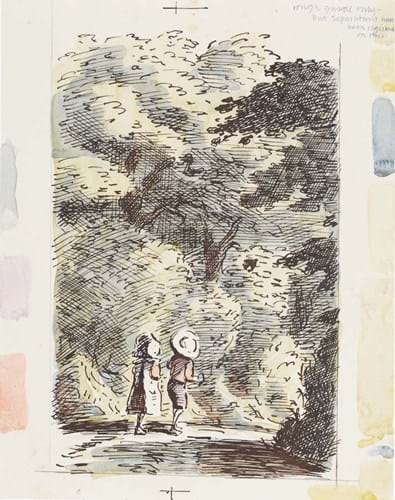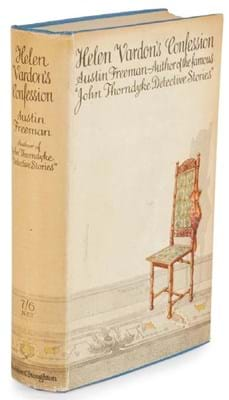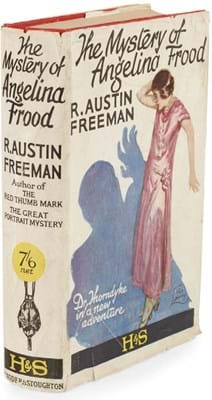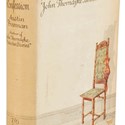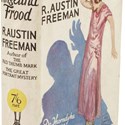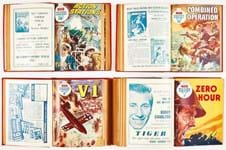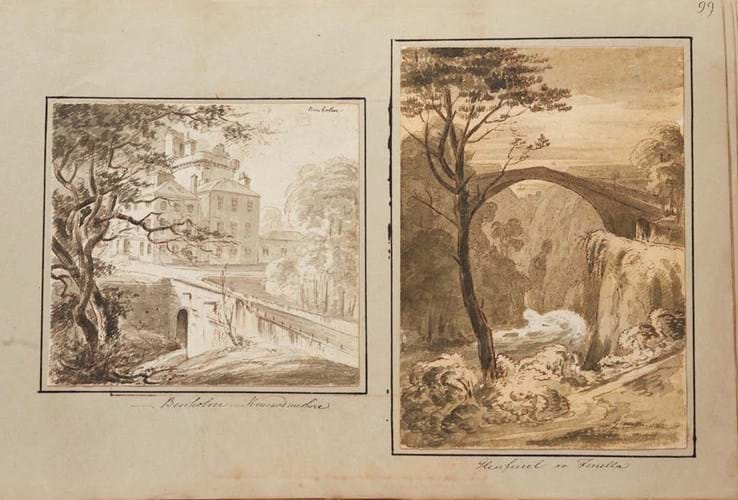
Original illustrations and artworks probably inspired by a friendship with Sir Walter Scott featured in an album that impressed in a recent Edinburgh auction.
Bid to a treble-estimate £34,000 at Lyon & Turnbull (25/20% buyer’s premium) on February 24-25, the group comprised 420 sketches in pencil and ink wash, including both full-page illustrations and other smaller studies, that dated from the years 1793-1834.
Mainly Scottish scenes, and accompanied by a few manuscript notes, they appear to be mostly the work of Sir James Skene of Rubislaw, said the saleroom.
The album is thought to have been purchased at auction in the 1950s and to have some connection with the Stevenson family of lighthouse and literary fame. However, what is more intriguing in this instance is the fact that several of the sketches seem to have been produced in collaboration with, or at the encouragement of, Sir Walter Scott.
Born in 1775, Skene, having inherited the family estate at the age of 16, following the untimely death of his elder brother, was sent to university in Germany and a sketch of his lodgings while in Hanau is one of the earlier drawings in the album.
A lawyer by profession, Skene also proved to be a talented amateur artist and as a young man formed a close friendship with Scott. Some 28 sketches in the album relate to localities alluded to in the writer’s works. It seems likely that many of the sketches were made during Scott and Skene’s riding excursions to ruins, castles and sites of antiquarian importance.
Good deed
Among other earlier works in the 445-lot Edinburgh sale was a deed box containing a large quantity of correspondence addressed in the 18th and 19th centuries to the offices of Robert Scott, Fairley & Company, which acted for the East India Company and for plantation owners in other parts of the British Empire.
It made a much higher than expected £16,000.
The sale’s most expensive purchase was something very different and much later in date, being one of just 500 first issue copies of Harry Potter and the Philosopher’s Stone printed in 1997.
An ex-library example, it had a label indicating its withdrawal from circulation, a laminated barcode to the front free endpaper and a neat label pasted onto the publication details page. It also showed some restoration work, as well as very slight browning and soiling internally. Even so, it sold at £39,000.
Accompanied by a letter of 1970 that begins “Dear Mr Craig, Here are the overlays and colour tabs for ‘The Young Ardizzone!’…” was a pictorial lot that sold at £14,000.
This Young Ardizzone was a collection of 27 ink and watercolour illustrations in a cloth-bound dummy book, along with a loose ink and watercolour illustration for the dustjacket of the book as published that year by Studio Vista.
But that letter also made mention of a particular colour request. It makes it very clear that Ardizzone has deliberately included a young boy in purple trousers on the dust-jacket of his book, and asks that the purple be retained – but it seems his request was not heeded and the young boy on the book’s cover is wearing white trousers!
Detective work
Two more detective story record-breakers from this Scottish sale can be added to those featured in the ATG No 2485 report on the Sotheby’s sale of the Alexis Galanos collection.
Works by R Austin Freeman, they were both copies that he had inscribed for his son, Lawrence Austin Freeman, and they sold at £1800 apiece. Helen Vardon’s Confession was published by Hodder & Stoughton in 1922 and The Mystery of Angelina Frood appeared in 1924.
Tinkle til you drop
A musical ending to this selection of lots from the Scottish sale is provided by a lot that offered composer Kaikhosru Sorabji’s corrected proof sheets for his Opus Clavicembalisticum.
When first performed in Glasgow in 1930, this was the longest single piano piece in existence, lasting over four hours. From 1936 and for 40 years thereafter, however, Sorabji instituted a ‘ban’ on the performance of all his works, stating: “no performance at all is vastly preferable to an obscene travesty”.
This may have been prompted, said the cataloguer, by a performance of the first part of Opus Clavicembalisticum that lasted twice as long as stipulated by the score.
The lot sold at £4400.


